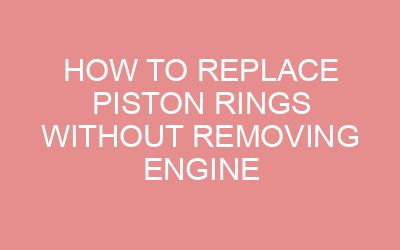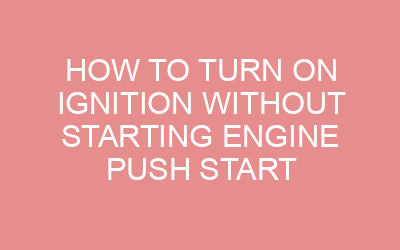To remove an oil pan without removing the engine, support the engine and unbolt the motor mounts. Then, carefully lower the oil pan for access.
Removing an oil pan without taking out the engine is a complex procedure that requires precise steps and attention to detail. By following the correct steps, you can successfully remove the oil pan without the need to remove the engine, saving time and effort in the process.
It’s not uncommon for vehicle owners and mechanics to encounter the need to remove an oil pan without having to take out the entire engine. Whether it’s for maintenance, repairs, or upgrades, this task can seem daunting. However, with the right guidance and approach, it can be accomplished effectively. In this guide, we will explore the step-by-step process of removing an oil pan without the need to remove the engine, providing a practical solution for this common automotive challenge.
Tools And Equipment Needed
Removing the oil pan without taking out the engine is a task that requires the right tools and equipment. It can be done with a few basic tools and some patience. Here’s a guide on the essential items you’ll need to get the job done.
List Of Tools
- Socket wrench set
- Adjustable wrench
- Oil filter wrench
- Scraper or putty knife
- Jack and jack stands
- Rubber mallet
- Torque wrench
Special Equipment Required
If the oil pan is difficult to access, you may require some special equipment such as:
- Engine support brace
- Oil pan gasket sealant
- Lifting sling or chain
- Oil drain pan
When working on a car, safety gear is crucial. Ensure you have the following items:
- Safety goggles
- Gloves
- Protective clothing
- Work boots
Preparation Steps
When it comes to tackling a car maintenance project, removing the oil pan without removing the engine is a great way to save time and effort. However, it requires meticulous preparation and attention to detail to ensure a smooth process. In this section, we will cover the crucial preparation steps you need to take to successfully remove the oil pan without the need to remove the engine.
Drain The Oil
Before beginning the process of removing the oil pan, it’s essential to safely drain the oil from the engine. To do this:
- Locate the oil drain plug underneath the vehicle.
- Place a suitable container beneath the plug to catch the oil.
- Carefully loosen the plug to allow the oil to flow out.
- Once the oil has drained completely, securely reattach the drain plug.
Lift The Vehicle
Next, you’ll need to elevate the vehicle to create space to work comfortably underneath. Follow these steps to lift the vehicle:
- Use a floor jack to lift the front of the vehicle. Ensure to place the jack at the recommended lifting points for safety.
- Slide sturdy jack stands beneath the vehicle to support it securely once it’s raised.
- Slowly lower the vehicle onto the jack stands, ensuring stable and even placement.
Secure The Engine
Before proceeding to remove the oil pan, it’s crucial to stabilize the engine to prevent any unexpected movement. Here’s how to secure the engine:
- Identify suitable engine lifting points and attach an engine support bar to lift and secure the engine.
- Tighten the support bar to ensure stability and security during the oil pan removal process.
Remove Components In The Way
It’s likely that there are components obstructing access to the oil pan. You’ll need to remove these obstacles carefully to proceed. Here’s how to do it:
- Identify and remove any undercarriage shields, exhaust components, or other parts blocking access to the oil pan.
- Label and organize the removed components to simplify reassembly later.
Removing The Oil Pan
Removing the oil pan is an essential part of maintaining your vehicle’s engine. Whether you need to replace a gasket or clean out sludge, having access to the oil pan without removing the engine can save you time and effort. Below, we’ll walk through the steps to remove the oil pan without the need to remove the engine, making this task more manageable for car owners and DIY enthusiasts.
Loosening The Oil Pan Bolts
Before you start loosening the oil pan bolts, it’s crucial to ensure your vehicle is safely elevated using ramps or jack stands. Once you have secured your vehicle, begin by locating the oil pan under the engine. Using the correct size socket or wrench, carefully loosen each bolt in a crisscross pattern to prevent warping the pan. After the bolts are sufficiently loose, place a drain pan underneath the oil pan to catch any oil that may spill out during the removal process.
Carefully Removing The Oil Pan
With all the bolts loosened, use a rubber mallet to gently tap around the edges of the oil pan to break the seal created by the gasket. Once the seal is broken, slowly and steadily lower the pan, ensuring no parts of the engine or other components interfere with its removal. Take care to avoid damaging the pan or causing any debris to fall into the engine during this process.
Inspecting The Gasket
After removing the oil pan, carefully inspect the gasket for any signs of wear, cracking, or damage. A damaged gasket can lead to oil leaks, so it’s important to thoroughly examine the gasket before reassembly. If needed, replace the gasket with a new one to ensure a proper seal and prevent future leaks.
Cleaning The Oil Pan
Before reinstalling the oil pan, it’s essential to clean it thoroughly to remove any accumulated sludge, debris, or remnants of the old gasket. Use a suitable solvent and a brush to meticulously clean the interior and exterior of the pan. Once clean, inspect the pan for any signs of damage or rust that may require further attention.
Reinstallation And Testing
After successfully removing the oil pan without detaching the engine, the reinstallation process is crucial to ensure optimal performance and functionality. The following steps guide you through the reinstallation process and the necessary testing procedures to confirm a secure and leak-free setup.
Installing A New Gasket
Before reattaching the oil pan, it is essential to install a new gasket to ensure a proper seal and prevent oil leakage. Choose a high-quality replacement gasket that matches the specifications of your vehicle’s engine. Carefully position the new gasket onto the cleaned mating surface of the engine block, ensuring it sits flush and securely in place.
Reattaching The Oil Pan
Once the new gasket is in position, proceed to reattach the oil pan. Align the oil pan with the engine, taking care to secure it without disturbing the gasket. Exercise caution to avoid over-tightening the bolts, as this could lead to damage to the gasket or the pan. Use the recommended torque specifications for the bolts to ensure a proper and secure fit.
Adding New Motor Oil
After reattaching the oil pan, add fresh motor oil to the engine. Check the manufacturer’s recommendations for the appropriate oil viscosity and capacity. This step is crucial to ensure proper lubrication and function of the engine’s components.
Testing For Leaks
Once the oil pan is reinstalled and the motor oil is added, it is essential to perform a thorough inspection for leaks. Start the engine and allow it to run for a few minutes, then inspect the perimeter of the oil pan and the engine block for any signs of leakage. If leaks are detected, take immediate action to address the issue before continuing to use the vehicle.
Tips And Troubleshooting
Discover expert tips and troubleshooting to remove the oil pan without the need to remove the engine. This efficient technique saves time and effort, allowing for smooth and hassle-free maintenance. Gain valuable insights on the step-by-step process and the necessary precautions to ensure a successful oil pan removal.
Common Issues
When removing the oil pan without taking out the engine, there are several common issues that you may encounter. These include stubborn bolts, restricted access to certain areas, and potential oil leaks after reinstallation. Moreover, the risk of damaging other components during the process should not be neglected.
Troubleshooting Techniques
Here are some troubleshooting techniques to address the common issues:
- Use of penetrating oil to loosen stubborn bolts
- Utilize specialized tools, such as swivel sockets and universal joints, to access tight spaces
- Inspect all mating surfaces and gaskets thoroughly to ensure proper sealing
- Apply a thread locker to reinstalled bolts to mitigate the risk of loosening
Expert Tips For Success
For a successful oil pan removal without engine disassembly, consider these expert tips:
- Gradually loosen bolts in a crisscross pattern to prevent warping the oil pan
- Label and organize removed components for efficient reassembly
- Place a protective cover over the exposed engine to prevent debris from falling in
- Perform a thorough inspection of the oil pan and surrounding components for signs of damage or wear
Safety Considerations
As with any automotive maintenance task, safety should always be a priority. When working around the engine and underneath the vehicle, it is essential to use proper jack stands and ensure the engine is adequately supported to prevent accidents and injuries.
Frequently Asked Questions On How To Remove Oil Pan Without Removing Engine
How Can I Remove An Oil Pan Without Removing The Engine?
To remove the oil pan without removing the engine, you’ll need to lift the vehicle, drain the oil, and remove the necessary components to access the oil pan. With the right tools and precautions, it can be done without removing the entire engine.
What Tools Are Needed To Remove An Oil Pan Without Removing The Engine?
You’ll need a jack, jack stands, a socket set, a wrench, and a scraper to remove the oil pan. Additionally, having a oil filter wrench, gasket sealant, and a drain pan handy will make the job easier and more efficient.
Are There Any Safety Precautions I Should Take When Removing The Oil Pan?
Before attempting to remove the oil pan, ensure the engine is cool, and that the vehicle is safely elevated with the proper support. Double-check that the oil has been drained completely to avoid any spills or accidents during the process.
Always wear protective gear and exercise caution.
Conclusion
To sum up, removing the oil pan without taking out the engine is achievable and can save time and effort. With the proper tools, approach, and precautions, this task can be completed successfully. Following the outlined steps and safety measures can ensure a smooth and efficient process.
Gear up and get oil pan removing!
{ “@context”: “https://schema.org”, “@type”: “FAQPage”, “mainEntity”: [ { “@type”: “Question”, “name”: “How can I remove an oil pan without removing the engine?”, “acceptedAnswer”: { “@type”: “Answer”, “text”: “To remove the oil pan without removing the engine, you’ll need to lift the vehicle, drain the oil, and remove the necessary components to access the oil pan. With the right tools and precautions, it can be done without removing the entire engine.” } } , { “@type”: “Question”, “name”: “What tools are needed to remove an oil pan without removing the engine?”, “acceptedAnswer”: { “@type”: “Answer”, “text”: “You’ll need a jack, jack stands, a socket set, a wrench, and a scraper to remove the oil pan. Additionally, having a oil filter wrench, gasket sealant, and a drain pan handy will make the job easier and more efficient.” } } , { “@type”: “Question”, “name”: “Are there any safety precautions I should take when removing the oil pan?”, “acceptedAnswer”: { “@type”: “Answer”, “text”: “Before attempting to remove the oil pan, ensure the engine is cool, and that the vehicle is safely elevated with the proper support. Double-check that the oil has been drained completely to avoid any spills or accidents during the process. Always wear protective gear and exercise caution.” } } ] }













Leave a Reply